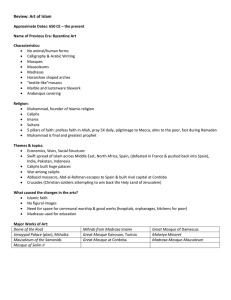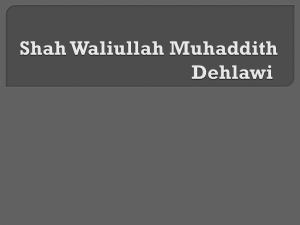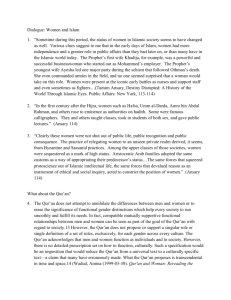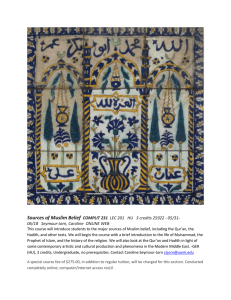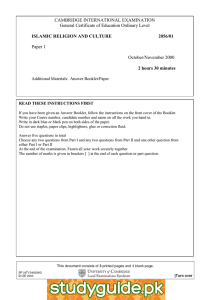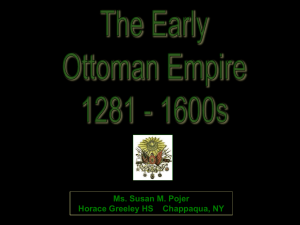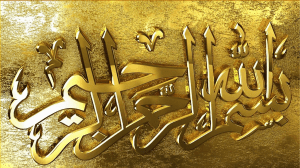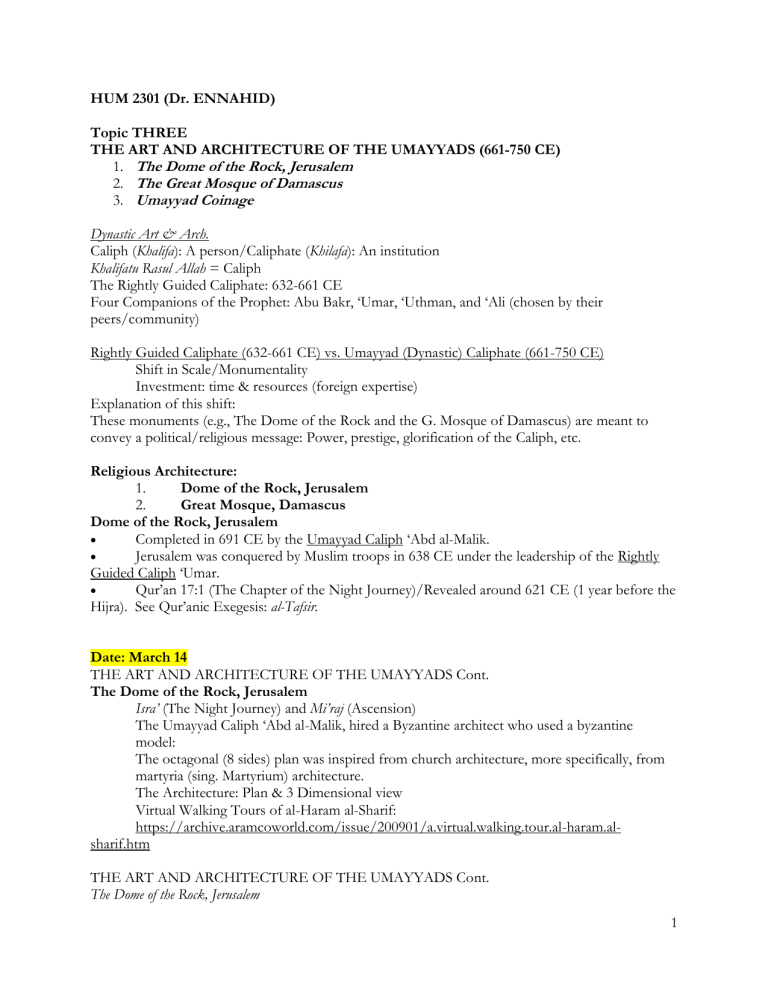
HUM 2301 (Dr. ENNAHID) Topic THREE THE ART AND ARCHITECTURE OF THE UMAYYADS (661-750 CE) 1. The Dome of the Rock, Jerusalem 2. The Great Mosque of Damascus 3. Umayyad Coinage Dynastic Art & Arch. Caliph (Khalifa): A person/Caliphate (Khilafa): An institution Khalifatu Rasul Allah = Caliph The Rightly Guided Caliphate: 632-661 CE Four Companions of the Prophet: Abu Bakr, ‘Umar, ‘Uthman, and ‘Ali (chosen by their peers/community) Rightly Guided Caliphate (632-661 CE) vs. Umayyad (Dynastic) Caliphate (661-750 CE) Shift in Scale/Monumentality Investment: time & resources (foreign expertise) Explanation of this shift: These monuments (e.g., The Dome of the Rock and the G. Mosque of Damascus) are meant to convey a political/religious message: Power, prestige, glorification of the Caliph, etc. Religious Architecture: 1. Dome of the Rock, Jerusalem 2. Great Mosque, Damascus Dome of the Rock, Jerusalem • Completed in 691 CE by the Umayyad Caliph ‘Abd al-Malik. • Jerusalem was conquered by Muslim troops in 638 CE under the leadership of the Rightly Guided Caliph ‘Umar. • Qur’an 17:1 (The Chapter of the Night Journey)/Revealed around 621 CE (1 year before the Hijra). See Qur’anic Exegesis: al-Tafsir. Date: March 14 THE ART AND ARCHITECTURE OF THE UMAYYADS Cont. The Dome of the Rock, Jerusalem Isra’ (The Night Journey) and Mi’raj (Ascension) The Umayyad Caliph ‘Abd al-Malik, hired a Byzantine architect who used a byzantine model: The octagonal (8 sides) plan was inspired from church architecture, more specifically, from martyria (sing. Martyrium) architecture. The Architecture: Plan & 3 Dimensional view Virtual Walking Tours of al-Haram al-Sharif: https://archive.aramcoworld.com/issue/200901/a.virtual.walking.tour.al-haram.alsharif.htm THE ART AND ARCHITECTURE OF THE UMAYYADS Cont. The Dome of the Rock, Jerusalem 1 The nature of Mosaic Decoration: Themes depicted, etc. Sources of inspiration Description/Interpretation of the mosaic elements: motifs and epigraphy. Muslim restriction as to what to be depicted on the building: A religious Space The mosaic decoration from the inside of the building: • A very expensive building. • Foreign expertise: Byzantine mosaicists (an expert in mosaic decoration). • Iconoclastic: 280 square meters of mosaics; the absence of the human figure; the emphasis on floral design/geometry/arabesque/epigraphy (inscriptions). • Meaning of these mosaics: Some of the motifs represent insignia of power (e.g., the wings on the crown of the defeated Persian/Sasanian king) to show the triumph of the Umayyad empire over rival political entities. • Epigraphy: Qur’anic text, most specifically, Christological passages (i.e., verses of the Qur’an related to Jesus Christ/al-Masih); please note the absence of the Night Journey verse (17:1)! THE ART AND ARCHITECTUR OF THE UMAYYADS Cont. Date: March 16 The Great Mosque of Damascus: Architecture Built by the Umayyad Caliph al-Walid, 706 CE. The mosque was built on a site of a church (tomb of Saint John the Baptist). Plan & 3 Dimensional view The Great Mosque of Damascus: Mosaic Decoration • Iconoclastic: Absence of human/animal figures • Very realistic depiction of nature • The introduction of a new element (compared to the mosaic decoration at The Dome of Rock): Depictions of buildings (architectural themes). • The Meaning of these architectural themes: 1. Depiction of a city of God (Paradise) 2. The towns of the world. 3. Symbol of Umayyad conquest. Date: March 23 1. GENERAL BACKGROUND ON ISLAMIC COINAGE 2. UMAYYAD COINAGE (CURRENCY) Case Study: Almoravid Dinar: Hegira 537 / AD 1142 Source: http://islamicart.museumwnf.org/database_item.php?id=object;ISL;dz;Mus01;28;en NUMISMATICS https://www.bkam.ma/musee http://numismatics.org/ 1. Materials 2. Epigraphy 3. Iconography 4. Chronology 2 5. Patronage 6. Ideology 7. Toponymy Numismatics: The scientific study of coinage in terms of: Denominations: • Materials: Gold, silver, and copper; to link the following coinage denominations (terms) in Islamic coinage: o Dinar (Gold): denarius (Latin); the term is mentioned in Qur‘an: 3:75. o Dirham (Silver): drachma (Greek); Qur‘an, see Chapt. of Joseph. o Fals (Copper): follis (Latin) Gold/Tibr: The Sudan & The Almoravids; gold traffic (long-distance vs. local exchange), purity of gold, sources of the Almoravid gold; medieval West Africa (Ennahid, The Oxford Handbook of African Archaeology, OUP, 2013). Transition from barter, coinage, (the check was introduced, but it did NOT supplant/replace coinage): The 42,000 dinars check or Sakk (178.5 kgs); Awdaghost (about 1,660 kms south of Sijilmassa); Ibn Hawqal (X CE). Date: March 28 • Epigraphy: Informs us about the place (toponym, toponymy = the study of place names) of production (e.g., Almeria, Spain). Dar al-Sikka (The mint): The personnel working at Dar al-Sikka is called die makers (al-Sakkak). Chronology: The date (year) when the coin was minted. Name and political/religious title of the issuing authority (sakka al-nuquda bi ismihi), e.g., Amir al-Mu’minin (The Commander of the Faithful) vs. Amir Muslimin (The Commander of the Muslims). The dominant religion (Islam): Profession of Faith (al-Shahada), the Caliph’s title, and Qur’anic verses. • Ideology: The use of religious/ideological elements to promote a political/religious agenda, e.g., the competition between the Almohad and the Marinid dynasties in Morocco (al-Mahdi Imamuna vs. al-Qur’an Imamuna) April 4 • Iconography: images shown on the coins; e.g., the portrait of a king meant to convey political/religious power; symbols such as crosses (for Christians) to show the dominant religion. • Patronage/The issuing authority: Name and political/religious title of issuing authority (sakka al-nuquda bi ismihi)/The portrait of a king meant to convey political/religious power. Phase I The Early Muslim Community 610-632 CE 632-661 CE: Rightly Guided Caliphate Phase II 661-750 CE Dynastic Caliphate: Umayyad Caliphate TWO Regions: 3 1. Former Persian/Sasanian/Sasanid Territories (Silver Coinage): Introduction of minor changes to Persian coinage: a. Kept the portrait of the defeated Persian king b. Removing the Fire Altar (Zoroastrianism/Majusiyya) and changing it with the caliph leading the prayer. c. Arabic Epigraphy: Religious text d. Pahlavi script: The name of the Muslim Governor, date, etc. Date: April 6 « Le Coran, Aux Origines du Livre » (History of the Qur’an), Video in Eng. Projection Date: April 11 2. Former Byzantine Territories: Gold Coinage De-Christianization: Removal of Christian signs/symbols from coinage a. Cross: Removal of the horizontal bar from crosses b. Removal of crosses from imperial crowns1 c. Christ Monogram (χριστός/Christos): made out of the two first letters of Jesus’ name in Greek (link to Ottoman Sultan’s Tughra); See the main porch of St. Pierre Cathedral. Rabat, Morocco. Phase III Major Currency Reform by Caliph ‘Abd Al-Malik: 695-697 CE Removal of all images (iconography) from Muslim coinage Aniconic: Exclusively (Arabic) epigraphic: Religious text (e.g., Qur’an 112:1-4/Chapt. of the Oneness/al-Ikhlas), in addition chronology, etc. NEW TOPIC THE ART AND ARCHITECTURE OF THE ‘ABBASIDS Baghdad & Samarra: Discussion PENDING THE ARTS OF THE BOOK “Oldest' Koran found in Birmingham - BBC News” https://www.youtube.com/watch?v=jowQond7_UE&list=LLQgwrVdFood_bGSh9qh9J0A&index =102 Methods for dating of archaeological objects (made of organic material): Carbon Dating C14 The Birmingham Univ. Qur’an dates to 645 CE (The Prophet passed away 632 CE). Manuscript: A book written by hand, e.g., A Qur’anic manuscript. Parchment = Processed animal skin (goat, sheep…) Riqq (processed animal skin of gazelle): Noble and durable Parchmenter = Raqqaq Absolute dating (C14) vs. Relative dating (Paleography) Paleography = The study of old scripts (al-Khatt); paleographers Colophon: The last page of a manuscript (incl. Qur’an), usually with the name of the patron, the calligrapher, and the date when the manuscript was completed (e.g., Sultan Baybars' Qur'an). Date: April 13 4 THE BLUE QUR’AN https://www.metmuseum.org/art/collection/search/454662 • Ink application: “As with the pages of the celebrated “Blue Qur’an” (see cat. no. 2), the execution of this Qur’an folio in gold Kufic script on vellum involved the lengthy and expensive process called chrysography The letters were written in “liquid glue,” filled in with a careful application of ground gold suspended in a solution, and finally outlined with pale brown ink using a thinnibbed stylus. (…).” • Landscape orientation/Few lines of text; large number of folios (114 chapters/6,000 verses) • “Indigo-dyed [colored] parchment” to create a powerful impact using the contrast element (Gold text on dark blue surface). • Script on the Blue Qur’an Paleography: The scientific study of old scripts. Old Arabic Script: Rudimentary and simple/basic form of Arabic script: missing diacritical marks (al-tanqit) and vowel signs (al-Shakl). Introduction of diacritical marks and vowel signs: Umayyad Period. Date: April 18 THE ARTS OF THE BOOK Cont. Pre-Printing Press Period: I.SCRIBE/COPYIST/CALLIGRAPHER: Scribe: Person in charge of writing down a particular content (religious/secular). 610 CE-632 CE: The Revelation Zayd Ibn Thabit (d. 665 CE) was one the three scribes working for the Prophet. Copyist: Person making copies of the original text written by the scribe. Calligrapher is an artist; calligraphy is the art of beautiful handwriting (manuscript illumination = embellishing of manuscripts). The British Library: Turning the Pages: Authorship & Chronology: Colophon is a statement with the name of the author/date. “This is the colophon of the seventh and final volume of the Baybars Qur'an. Each volume ends with a page devoted to the colophon, providing the names of those involved in its production. The bottom line dates the completion of the copying of the text. The Baybars Qur'an is the earliest dated Qur'an from the Mamluk period. Rukn al-Din Baybars is mentioned as the patron of this copy of the Qur'an in line 3. Muhammad ibn alWahid is identified as the calligrapher in line 4. This Qur'an is the only known example of this calligrapher's work to survive. The large decorated hasp, unlike volume three, does not contain Sandal's signature, although this page was illuminated by him. The last line states that this Qur'an was completed in its entirety in the year 705 [AH] of the Muslim calendar, corresponding to the years 1305-1306 AD.” Source: https://www.bl.uk/turning-the-pages/?id=0354faf0-a67a-11db-87d30050c2490048&type=book [The Baybars Qur'an: pp. 34-35]. 5 II.THE STANDARDIZATION OF THE ARABIC SCRIPT (A Major Contribution to Arabic Calligraphy) Handwritten Documents: Manuscripts (NOT printed books) a. The Tool (reed pen): The making of the reed pen following pre-determined specifications. b. The Unit of Measurement: The dot of ink pressed on a piece of paper using a reed pen. ‘Abbasid Calligrapher: IBN MUQLA (886-940 CE): The calligrapher who invented PROPORTIONAL CALLIGRAPHY (A method for the standardization of the Arabic Script) 28 letters of the Arabic Alphabet Set standards (rules) for 1) each letter of the 28 letters of the Arabic Alphabet and 2) for 6 different scripts (x 28). Reed (Qasab) pen Scale of execution/production: e.g., the Mecca Clock Date: April 20 [on MS TEAMS] Islam Empire of Faith [PBS Documentary]: Part II Date: April 27 III.MEDIA/SCRIPTS/CONTENT Medium: SCRIPTS Paleography: The scientific study of old scripts. Old Arabic Script: Rudimentary and simple/basic form of Arabic script: missing diacritical marks (al-tanqit) and vowel signs (al-tashakil). Improved Arabic Script with the introduction of diacritical marks and vowel signs: Umayyad Period. Different scripts used for different purposes/contexts. Two basic forms: 1. Kufic-based: Angular script/older script (very popular until the 11th cent. CE). 2. Naskhi-based: Cursive/Fluid script (from the 12th century CE onwards). Tuluth: Dignified/Noble Arabic Script a. Kiswa of the Ka‘ba b. Qur‘anic Manuscripts (e.g., Sheikh Uthman Taha, the calligrapher of the Mecca/Medina Qur’an). Regional Calligraphic Traditions: Arabic language and script origins Eastern (Mashriqi) vs. Maghribi (The Maghrib: North Africa and al-Andalus): Exp. Mosque Arch.: Hispano-Moorish, Ottoman, etc. Maghribi Script (The Maghrib: North Africa and al-Andalus): a. Mabsut: Qur’anic manuscripts (the equivalent of Tuluth in the Mashriq/Middle East) b. Mujawhar: Official correspondence/documents (royal letters, royal decrees, etc.) c. Musnad: Informal note taking, etc. 6 MEDIA Pre-Islamic Period (pre year 610 CE): Arab society was an oral society. e.g., Mu‘allaqat: Arabic poetry Epigraphic (inscriptions) evidence: Rare N.B. Ancient Egypt (Papyrus, Bardiyyat) or Mesopotamia (clay tablets): rich written record… Time of the Prophet Zayd Ibn Thabit (d. 665 CE): Rudimentary media (writing surfaces): Animal skin (parchment), shoulder blades of camels; processed palm branches, thin stones, etc. Gradual Process 610 CE: Qur‘an/scribe Zayd Ibn Thabit Memory-aid: Qur’anic content memorized/recited 632-661 CE: The establishment of Rightly Guided Caliphate (al-Khilafa al-Rashida): The first phases of the collection of the Qur’an. The Caliph ‘Uthman commissioned an official copy of the Qur’an known to us as the Standard Codex (al-Mushaf al-Imam). Post 661 CE: Dynastic Caliphate (The Umayyads) State/Empire formation: Administration/Record keeping… exp. Lists of soldiers, taxes, etc. Vibrant intellectual/Scientific movement… The first consequence: the improvement of the Arabic script and, second, the transition to a cheaper medium: PAPER! The introduction of Paper to the Muslim World: 750 CE. Context: As a consequence of battle (Talas); a group of Chinese prisoners who knew how to make paper; they taught the Arabs the technique of paper making. Mid- 10th: paper mills (workshop for paper making) Mass produced: mid-10th century = Paper mills (e.g., Fez); See Ennahid, Brill, 2011, section on paper making in Morocco. Leo Africanus (XVI): Kutubiyya Mosque 100 shops of booksellers (Moroccan Arabic: Kutbi meaning a bookseller). (See Amin Maalouf, Leo Africanus). CONTENT Secular (e.g., poetry, medical manuscripts, etc.) vs. Religious (e.g., Qur’anic manuscripts, Hadith books, etc.). Date: May 2 Topic NINE Learning and Worship: The Madrasa The Readings: Hillenbrand, R. 1994, The Madrasa, pp. 235-251 (PDF file) Full Ref.: Hillenbrand, R. 1994 Islamic Architecture. Form, Function and Meaning. Columbia University Press, New York. 7 DEFINITION AND EARLY EVOLUTION Madrasa/Jami‘/Kuttab • The madrasa (medersa) is an institution of higher education in which religious sciences are taught, such as fiqh (jurisprudence), tafsir (Quran exegesis), and hadith (Traditions). Most madrasas have living quarters for resident students. The madrasa was originally built to train the religious apparatus of the state (‘Ulama). E.g., the Qarawiyyin in Fez and Dar al-Hadith alHassaniyya in Rabat. • The madrasa as an educational institution developed at a relatively later date compared to other religious institutions. 1. Masjid 2. Masjid-Khan 3. Madrasa • The madrasa represents the last stage in the evolution of the Islamic educational institutions. • At first, religious studies were conducted in the masjid. The mosque of the Prophet can be considered as the first educational center in Islam; the Prophet and his Companions gathered in the mosque to pray but also to recite Quran, study its meanings, and discuss matters of belief and conduct. The Prophet also taught hadiths to his Companions • The best examples of mosques as centers of higher learning are the Qarawiyyin (A.D. 859), al-Azhar (A.D. 972), and the Zaytuna in Tunis. With the expansion of Islam and the growth of the Muslim community, students and scholars alike traveled great distances to seek knowledge (especially, collectors of hadiths). To accommodate out-of-town students, a hostelry (khan) was attached to the mosque, which gave rise to the masjid-khan complex. • The 11th century saw the end product of this evolution with the foundation of an institution that combined the roles of both the mosque and the khan: the madrasa. • The establishment of madrasas did not however encroach on the educational role of mosques; there was much overlap between the two institutions. • At first, each madrasa was founded for one madhhab (School of Islamic Law). Later madrasas were founded for two, three or even the four madhhabs. There was however a separation of students taught different madhhabs. Students of each madhhab were gathered in each of the four iwans opening onto the madrasa’s central courtyard (e.g., The Mosque-Madrasa of Sultan Hassan, AD 1356 and 1363). • • The flourishing of madrasas in the Islamic world was the result of an ambitious architectural program initiated by Nizam al-Mulk (bio. A.D. 1018-1092) (career: A.D. 1064-1092), a Saljuk vizier, who built several madrasas including the celebrated Madrasa Nizamiyya in Baghdad (A.D. 1067). MAGHRIBI MADRASAS • In the Maghrib, it was not until the Marinid period that the first madrasas were built. In fact, the foundation of madrasas is the hallmark of Marinid art and architecture. 8 The first madrasa in the Maghrib is Madrasa al-Saffarin (metal-workers) in Fas built in A.D. 1271 (A.D. 1285?) by Marinid sultan Abu Yusuf Ya‘qub b. ‘Abd al-Haq. Most Maghribi madrasas were built in Fas by Marinid sultans between A.D. 1271 and A.D. 1356. • ARCHITECTURE OF MAGHRIBI MADRASA • Compared to their eastern counterpart, Maghribi madrasas have small dimensions (about 14 m x 14.5; 35 m x 36 m for eastern madrasas). The small size of maghribi madrasas is due to 1) their exclusive teaching of the Maliki madhhab and 2) the lack of building space within the medina. • A classic plan of a Maghribi madrasa includes: 1. A bent-axis entryway: a feature borrowed from domestic architecture. In madrasa architecture the length of the corridor allows the visitor time to adjust from the bustle of street life to the quiet of a place of learning and worship. 2. A central courtyard with a fountain or a pool in the middle 3. A mosque along the main axis of the courtyard; it functioned as a lecture-hall outside regular prayer hours. Axiality was a major concern since the prayer hall was kept along the main axis of the building even if it runs counter the correct orientation of the qibla (see Attarin madrasa ‘perfumers’ where the main axis of the prayer hall is perpendicular to that of the building; axiality was maintained by placing the entrance to the prayer hall to the left of the mihrab). 4. Two, three or four lateral galleries surrounding the courtyard and delimited by panels of lattice woodwork (mashrabiyas). 5. Student cells opening onto the lateral galleries and/or overlooking the courtyard for cells located on the upper floors. Student accommodations are sealed off the courtyard by screens of lattice woodwork. At the small end of the scale, some student cells measure 1.50 m x 2 m barely big enough for one or at most two students. 6. Ablution facilities and latrines: a series of cubicles surrounding an auxiliary courtyard with a fountain in the middle. 7. In some cases, the right and left corridors branched off the main entrance gives access respectively to a minaret (Saffarin and Bu ‘Inaniyya’) and a staircase leading to an upper floor. XXXXXXXXXXXXXXX 9

